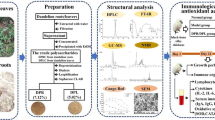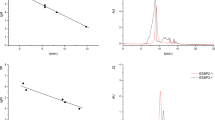Abstract
Epimedium polysaccharide (EPS) and isatis root polysaccharide (IRPS) were extracted, purified, and selenizingly modified by nitric acid-sodium selenite method to obtain nine selenizing EPSs (sEPSs), sEPS1–sEPS9 and nine selenizing IRPSs (sIRPSs), sIRPS1–sIRPS9, respectively. Their effects on chicken peripheral lymphocyte proliferation in vitro were compared by MTT assay. The results showed that selenium polysaccharides at appropriate concentration could promote lymphocyte proliferation more significantly than unmodified polysaccharides, sEPS5 and sIRPS5 with stronger actions were picked out and injected into the chickens vaccinated with Newcastle disease vaccine in vivo tests. The peripheral lymphocyte proliferation and serum antibody titer were determined. The results showed that sEPS5 and sIRPS5 could elevate serum antibody titer and promote lymphocyte proliferation more significantly than unmodified polysaccharides, sEPS5 possessed the strongest efficacy. These results indicate that selenylation modification can significantly enhance the immune-enhancing activity of EPS and IRPS, and sEPS5 can be as a new-type immunopotentiator of chickens.




Similar content being viewed by others
References
Vandamme E, Baets S, Steinbuchel A (2002) Polysaccharides I: polysaccharides and prokaryotes (biopolymers series)
Jiang X, Xu M, Yin YJ (2009) The bioactivity of polysaccharide and its application in animal production. Chin J Vet Med 36:31–34
Rioux S, Girard C, Dubreuil JD, Jacques M (1998) Evaluation of the protective efficacy of Actinobacillus pleuropneumoniae serotype 1 detoxified lipopolysaccharides or O-polysaccharide-protein conjugate in pigs. Res Vet Sci 65:165–167
Melo MRS, Feitosa JPA, Freitas ALP, Paula RCM (2002) Isolation and characterization of soluble sulfated polysaccharide from the red seaweed Gracilaria cornea. Carbohydr Polym 49:491–498
Zhang M, Cheung PCK, Ooi VEC, Zhang LN (2004) Evaluation of sulfated fungal b-glucans from the sclerotium of Pleurotus tuber-regium as a potential watersoluble anti-viral agent. Carbohydr Res 339:2297–2301
Wang XH, Zhang LN (2009) Physicochemical properties and antitumor activities for sulfated derivatives of lentinan. Carbohydr Res 344:2209–2216
Li G, Miu J, Liu F (2001) Selenium polysaccharide compounds and their preparation methods. Chinese Patent NO: CNn21414C
Yu W, Yang XM, Liu WM, Liu F, Ma HL (2009) Assay study on content of polysaccharides in Ficus carica by phenol-sulfuric acid method. Food Sci Technol 10:256–258
Gao J, Qin S, Huang K (2006) Assay of organic selenium and inorganic selenium of enriched yeast by hydride generation atomic fluorescence spectrometry method. J Anal Chem 22:157–159
Wang DY, Hu YL, Sun JL, Kong XF, Zhang BK, Liu JG (2005) Comparative study on adjuvanticity of compound Chinese herbal medicinal ingredients. Vaccine 23:3704–3708
Thekisoe MMO, Mbati PA, Bisschop SPR (2004) Different approaches to the vaccination of free ranging village chickens against Newcastle disease in Qwa-Qwa, South Africa. Vet Microbiol 101:23–30
Yu J, Jiang Z, Yan H, Zhu L (2005) Effect of pachyman on cell-mediated immunity activity and anti-tumor function in chicken infected with vMDV. Chin J Vet Sci Technol 34:70–73
Lu Y, Wang DY, Hu YL, Huang XY, Wang JM (2008) Sulfated modification of epimedium polysaccharide and effects of the modifiers on cellular infectivity of IBDV. Carbohydr Polym 71:180–186
Abula SFD, Wang JM, Hu YL, Wang DY, Sheng X, Zhang J, Zhao XN, Nguyen TL, Zhang YQ (2011) Screening on the immune-enhancing active site of Siberian solomonseal rhizome polysaccharide. Carbohydr Polym 85:687–691
Shang DJ, Wang GJ, Wang XM, Tian X, An Y (2001) Isolation, purification and property identification of two kinds of polysaccharide containing selenium in Ganoderma lucidum. J Dalian Univ Technol 41:165–168
Shang DJ, Cui Q, Tian X (2002) Separation, purification and molecular composition analysis of Ganoderma lucidum selenium polysaccharide SeGLP-2A. Chin J Edible Fungi 21:35–37
Shang DJ, Wang XM, Xu YT, Tian X, An Y (2002) Separation, purification and analysis of selenium activity structure of SeGLP-1. Acta Edulis Fungi 9:22–27
Xu CL, Wang YZ, Jin ML, Yang XQ (2009) Preparation, characterization and immunomodulatory activity of selenium-enriched exopolysaccharide produced by bacterium Enterobacter cloacae Z0206. Bioresour Technol 100:2095–2097
Thekisoe MMQ, Mbati PA, Bisschop SPR (2003) Diseases of free-ranging chickens in the Qwa-Qwa District of the northeastern Free State province of South Africa. J S Afr Vet Assoc 74:11–14
Staaf M, Yang Z, Widmalm G (2000) Structural elucidation of the viscous exopolysaccharide produced by Lactobacillus helveticus Lb161. Carbohydr Res 326:113–119
Behne D, Kyriakopoulos A, Scheid S, Gessner H (1991) Effects of chemical form and dosage on the incorporation of selenium into tissue proteins in rats. J Nutr 121:806–814
Hoffmann PR, Berry MJ (2008) The influence of selenium on immune responses. Mol Nutr Food Res 521:273–1280
McKenzie RC, Rafferty TS, Beckett GJ (1998) Selenium: an essential element for immune function. Immunol Today 19:342–345
Hawkes WC, Kelley DS, Taylor PC (2001) The effects of dietary selenium on the immune system in healthy men. Biol Trace Elem Res 81:189–213
Qin T, Chen J, Wang DY, Hu YL, et al (2013) Selenylation modification can enhance immune-enhancing activity of Chinese angelica polysaccharide. Carbohydr Polym 95:183–187
Qiu SL, Chen J, Qin T, et al (2014) Effects of selenylation modification on immune-enhancing activity of garlic polysaccharide. PLoS One 9:e86377
Acknowledgments
The project was supported by National Natural Science Foundation of China (31272596), Special Fund for Agro-scientific Research in the Public Interest (201403051), and a project funded by the Priority Academic Program Development of Jiangsu Higher Education Institutions. We are grateful to all other staff in the Institute of Traditional Chinese Veterinary Medicine of Nanjing Agricultural University for their assistance in the experiments.
Compliance with Ethical Standards
ᅟ
Conflict of Interest
The authors declare that they have no conflict of interests.
Ethical Approval
All procedures performed in studies involving animals were in accordance with the ethical standards of the Institutional Animal Care and Use Committee of the Laboratory Animal Research Center in Nanjing Agricultural University.
Informed Consent
Informed consent was obtained from all individual participants included in the study.
Author information
Authors and Affiliations
Corresponding author
Rights and permissions
About this article
Cite this article
Li, X., Hou, R., Yue, C. et al. The Selenylation Modification of Epimedium Polysaccharide and Isatis Root Polysaccharide and the Immune-enhancing Activity Comparison of Their Modifiers. Biol Trace Elem Res 171, 224–234 (2016). https://doi.org/10.1007/s12011-015-0511-4
Received:
Accepted:
Published:
Issue Date:
DOI: https://doi.org/10.1007/s12011-015-0511-4




